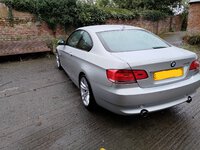I like your thought, and I don't know the answer. The only thing I have to add is that I'm under the impression e-diff actually makes a lot of intervention, even before big traction loss. I certainly could be wrong, I'm only under that impression because when I got my car CPO the sales guy was telling me about how the break pads wear faster from that, despite them supposed to not be wearing faster, because it's always applying break to adjust. Not sure if e-diff would be fighting the quaife or working together? It seems plausible the e-diff could be calibrated to play nice with the LSD though, if one knew how

The DSC system on the E89 aka DSC Mk60E5 has a number of functions as well as e-diff that rely on braking various wheels under various conditions...this from TIS
Functions familiar from current DSC:
- ABS: Anti-lock braking system
- EBV: Electronic brake force distribution
- CBC: Cornering Brake Control
- ASC: Automatic stability control
- DTC: Dynamic traction control
- MSR: Engine drag torque control
- DBC: Dynamic brake control
- RPA: Run Flat Indicator (not a driving dynamic control function)
- CBS: Condition Based Service (not a driving dynamic control function)
New functions for DSC Mk60E5:
- Brake Standby through pre-tensioning of the brakes in an emergency
- Brake disc drying on wet roads
- Fading compensation
- Soft stop when braking to standstill (only E87 with 6-cylinder engine, E90, E91, E92, E93)
- Start-off assistant
- Adapted interface for cruise control with brake function (only E90, E91, E92, E93)
- Adapted interface for active cruise control (only E90, E91, E92, E93)
So the brakes are used for..
BV: Electronic brake force distribution
EBV is a component of ABS and controls the brake force distribution between the front and rear wheels.
Advantage: Regardless of the load state of the vehicle, the best possible braking distance is achieved while driving stability is maintained.
Modern vehicles have relatively large brakes on the rear axle to shorten braking distances. To prevent the rear wheels from being overbraked in certain driving situations, EBV permanently monitors slip. EBV controls rear axle slip in dependence of the front axle.
CBC: Cornering Brake Control
CBC is an extension of ABS. CBC enhances driving stability if the brakes are applied when cornering.
Advantage: If the brakes are applied in a corner, optimum brake force distribution ensures optimum tracking stability.
When cornering, even very light braking can shift the axle-load distribution to the left or right so that driving stability is impaired. If required, CBC generates a stabilising load moment when the brakes are applied lightly outside the ABS intervention range.
ASC: Automatic stability control
ASC prevents the wheels from spinning when the vehicle is accelerating.
Advantage: Improved traction. The vehicle remains stable.
If one of the wheels of the drive axle is on a high-grip surface and the other is on a slippery surface, the wheel tending to skid is braked.
ASC also intervenes in the engine control (to reduce the ignition angle, injection quantity, throttle valve setting).
| |
| So it could be that the rear discs are used extensively in those situations..certainly my rear pads wear out far faster than the front ones... | |
| |



